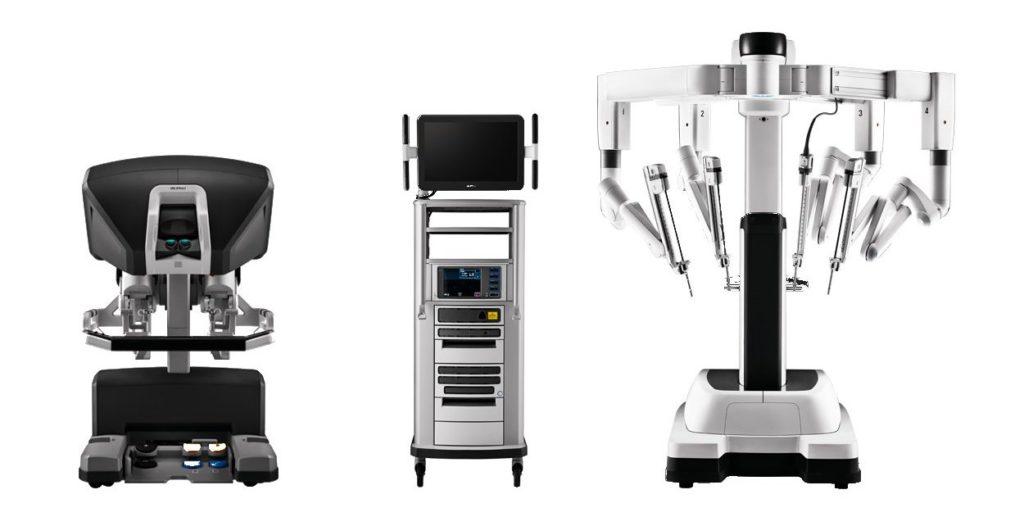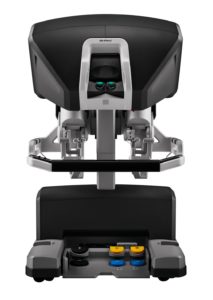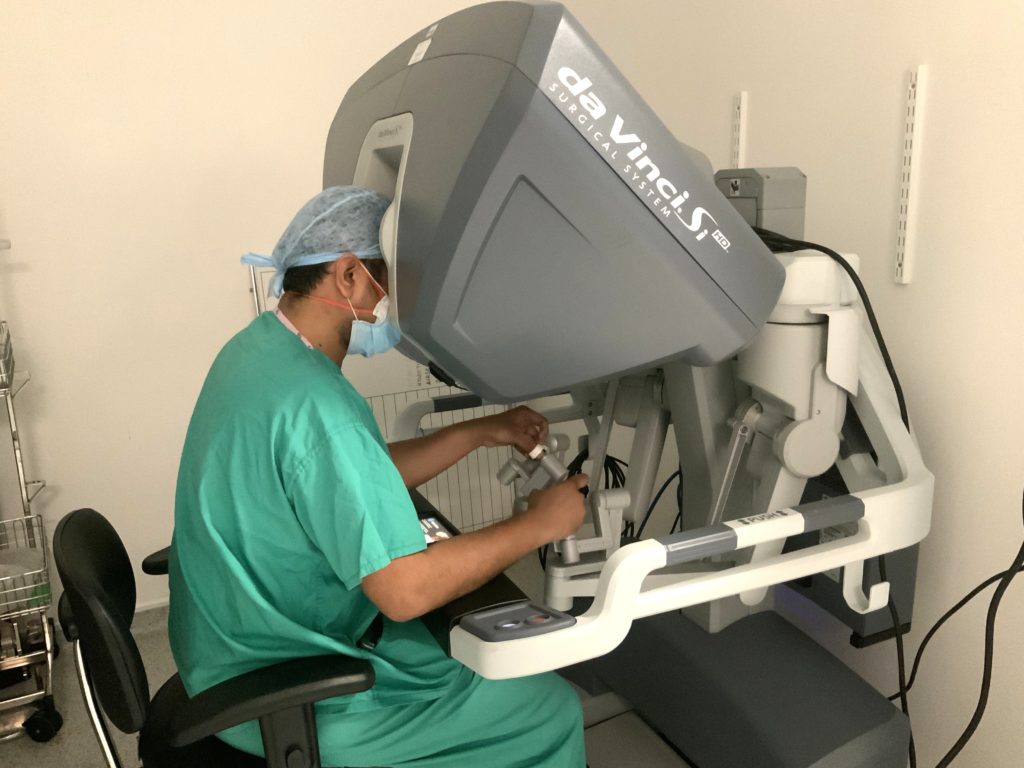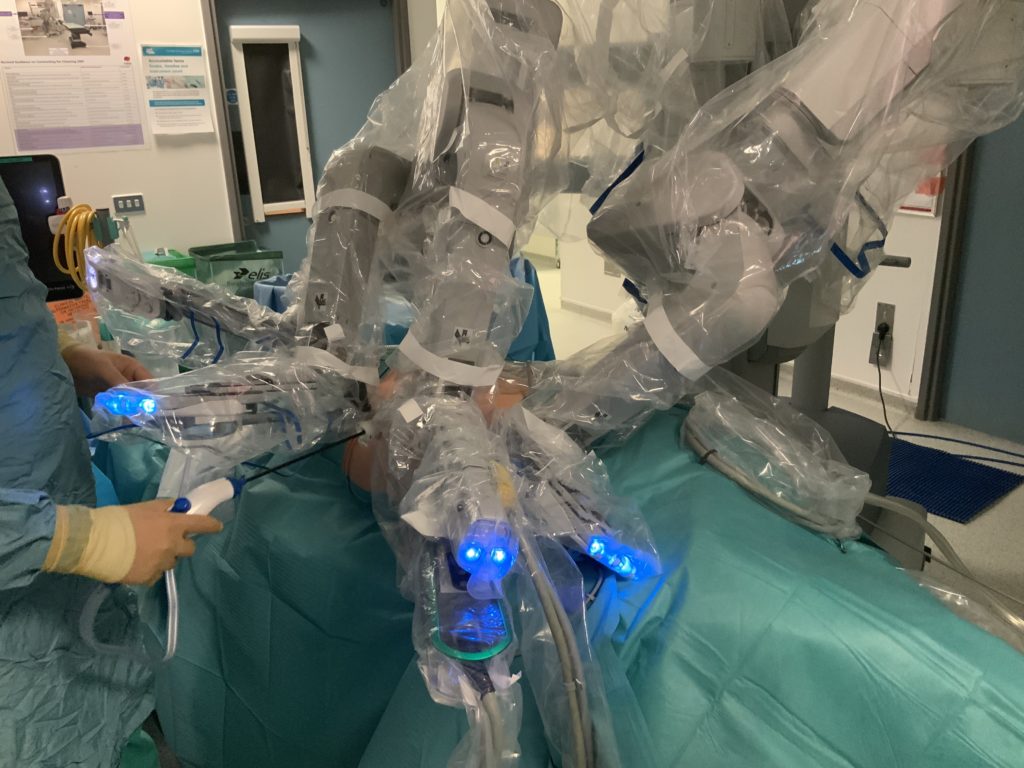What is robotic surgery?
Robotic surgery is an extension of laparoscopic (keyhole) surgery and offers advantages that overcome some drawbacks of laparoscopy. Most people are familiar with laparoscopy in which the surgery is performed by a surgeon standing at the side of the patient, manipulating straight instruments while viewing the movement of the instruments inside the body on a screen. There are usually a group of small incisions (1cm or less) made on the body to allow access for the ports and instruments.
During a robotic surgical procedure, the surgeon sits in the console of the da Vinci surgical system a few feet away from the patient. While watching through the console/video monitoring system, he/she moves the handles on the console in the directions he /she wants to move the surgical instruments. The handles on the console translate the surgeon’s natural hand and wrist movements into corresponding and very precise movements inside the body.
Using the da Vinci System, surgeons can operate with the look and feel of open surgery, performing complex surgical maneuvers. The surgeon has intuitive control, range of motion and fine tissue manipulation characteristic of open surgery. All of this is performed through small ports of minimally invasive surgery.
One obstacle of standard laparoscopy is the loss of three dimensional (3-D) spatial relationships since the screen has only a two dimensional view (2D), like a television. The da Vinci Surgical System uses a camera that provides the surgeon with a truly 3-D view of the surgical field. The physician looks through the vision system – like a pair of binoculars – and gets a 3-D view inside the patient’s body that allows the surgeon to experience the depth of the field being operated. The system also provides magnification ten-twelve times that of the naked eye, allowing the surgeon the ability to see the operating field more clearly.
Standard Laparoscopic instruments have the feel of “chop sticks”. However the DaVinci Surgical Cart uses EndoWrist® Instruments that are designed to mimic the movement of the human hands, wrists and fingers. The extensive range of motion allows precision that is not available in standard laparoscopy.
History of Robotics
The prototype for the da Vinci® robot was designed by the United States military and NASA with the hope of allowing surgeons to operate on wounded soldiers from a safe distance. Unfortunately, this goal was abandoned because the robot was not sufficiently portable for use in this capacity. Subsequently, the technology was sold to a private company (Intuitive Surgical) who adapted it for application in an operating theatre and developed an instrument that has become the most advanced tool in a surgeon’s armamentarium.
By integrating robotic technology with surgeon skill, the da Vinci® Surgical System enables surgeons to perform surgery in a manner never before experienced. It has improved and magnified the visibility and enabled considerably enhanced precision.
What are the Components of the Da Vinci System?

The Surgeon Console, which contains the master controls our surgeons use to manipulate the EndoWrist Instruments.

The InSiteTM Vision System, which gives surgeons a true 3-D view of the surgical field.
The EndoWristTM Instruments are designed to mimic the movement of the (surgeon’s) human hands, wrists, and fingers and extend their normal human range of motion.

The system cannot be programmed, nor can it make decisions on its own. The da Vinci System requires that every surgical maneuver be performed with direct input from the surgeon.
Patient-side Cart
This has four arms which hold the operating instruments and the camera. These follow the commands of the surgeon. Supporting surgical team members assist in installing the proper instruments, prepare the 1-cm ports in the patient, as well as supervise the laparoscopic arms and tools being utilized.

Why is it better for the surgeon?
With its 3-D view, the da Vinci Surgical System aids the surgeon to more easily identify vital anatomy such as the delicate nerves and blood vessels surrounding specific anatomy.
The EndoWrist® Instruments provide the surgeon with the dexterity not available using conventional laparoscopic instruments to perform a delicate and precise surgical dissection, reconstruction or removal of specific tissue.
What are the benefits to the patients?
The benefits of this minimally invasive surgery are significant to patients.
- Reduced trauma to the body
- Less blood loss and need for transfusions
- Less post-operative pain and discomfort
- Minimal need for pain killers
- Shorter hospital stay
